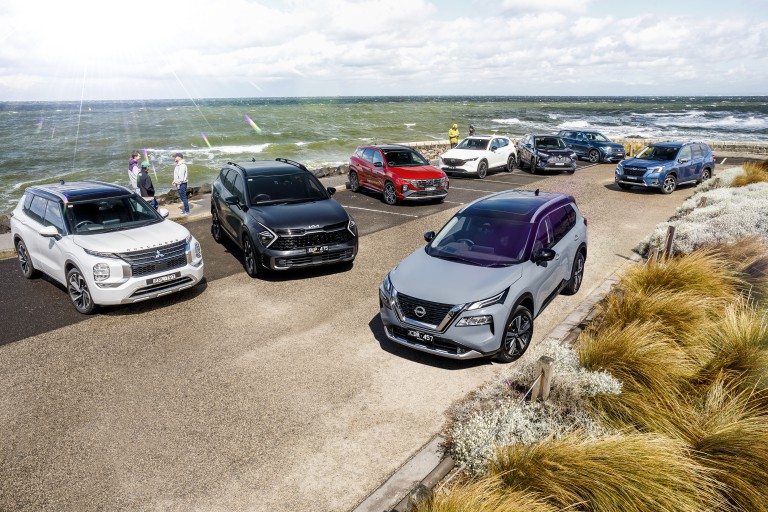
Which medium SUV is best for your family in 2023? Buckle in, let's go.
As far as battlegrounds go, the medium SUV segment is akin to the Battle of Helm’s Deep in The Lord of the Rings. Combatants stretch across the landscape as far as the eye can see, and while some are virtuous and noble warriors, the real difference is, unlike Tolkien’s fictional good-versus-evil clash, the fighters in this story are all in it for themselves.
The stakes are high for all, for the prize is dominance of Australia’s richest vehicular segment in terms of sales volume. In 2022, SUV sales accounted for 53.1 percent of the total Australian new-car market.
Of that gargantuan slice of the pie (can it really be called a slice when it’s now more than half the damn thing?), the medium SUV market accounted for 216,151 sales – or 37 percent of all SUV sales – and more than all passenger-car sales combined.
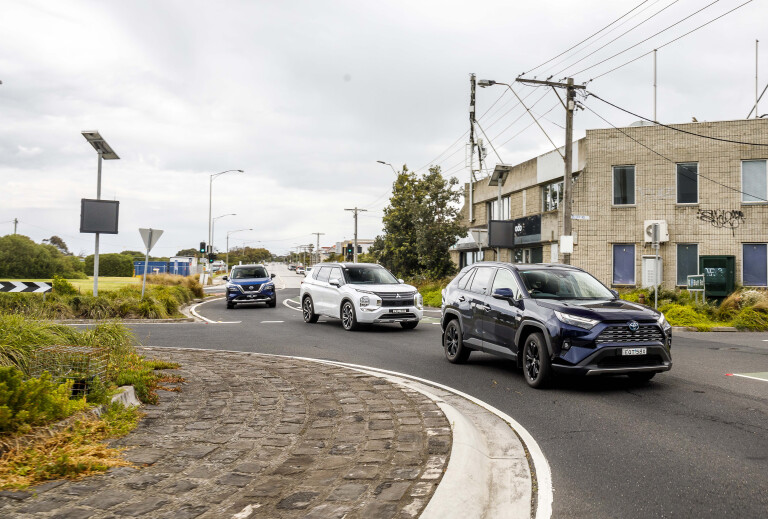
In 2022, SUV sales accounted for 53.1 percent of the total Australian new-car market.
A tale of eight SUVs
With so many contenders to choose from – there are 21 distinct models in the mainstream medium SUV segment at last count – it can be tricky to know which is best for you. That’s where this test comes in.
We’ve brought together eight of Australia’s best-selling and most-established medium SUVs, with a focus on selecting models that cost as close to $50K before on-road costs as possible.
The circa-$50K price point is one of the most popular with Aussie buyers and we’ve tested each contender comprehensively across seven key criteria: value, running costs, warranty/roadside assistance, boot space, rear-seat room/family duties, ride & handling, and tested fuel economy. Read on to see how they stack up.
JUMP AHEAD
- Which SUVs are competing?
- 🧰 Which medium SUV is the cheapest to service and maintain?
- ⛽ Which medium SUV is best on fuel use?
- 🛡️ Which medium SUV has the best warranty?
- 🧳 Which medium SUV has the best boot?
- 👨👩👧👦 Which medium SUV is best for family duties?
- 🛣 What are they like to drive?
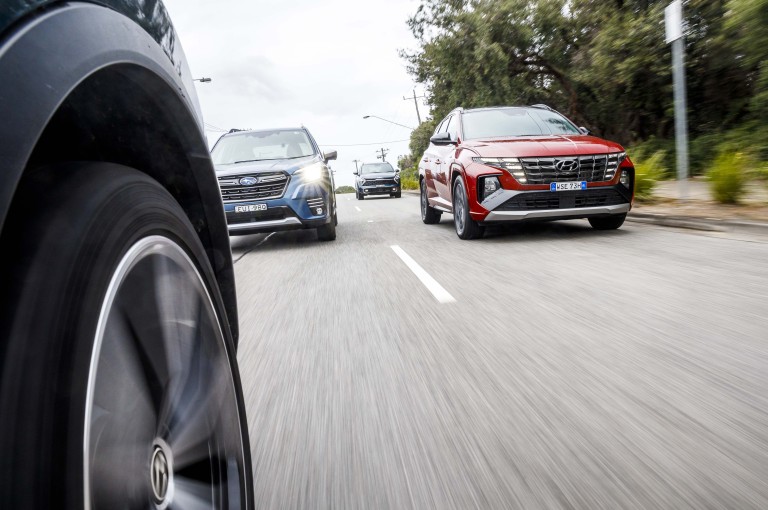
Which SUVs are competing?
Contenders & pricing
| Model | Price (before on-roads) | As-tested price (before on-roads) |
|---|---|---|
| Kia Sportage GT-Line diesel | $52,370 | $52,720 |
| Hyundai Tucson Highlander 1.6T N-Line | $50,400 | $51,900 |
| Mazda CX-5 GT SP | $51,690 | $52,485 |
| Mitsubishi Outlander Exceed Tourer | $52,490 | $53,908 |
| Nissan X-Trail Ti | $49,990 | $51,990 |
| Subaru Forester 2.5i-S | $46,340 | TBC |
| Toyota RAV4 Cruiser Hybrid 2WD | $48,200 | TBC |
| Volkswagen Tiguan 162TSI R-Line | $57,690 | $61,790 |
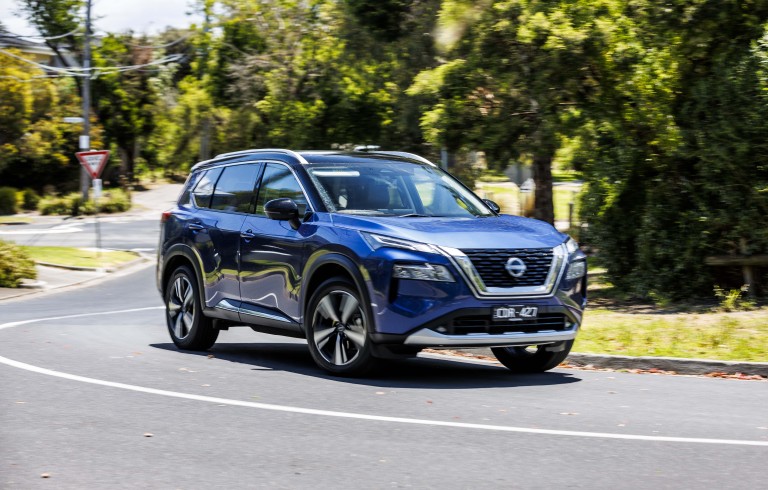
Cast an eye over our eight similarly priced contenders and you’ll notice some key differences. We have a mix of powertrains (naturally aspirated petrols, hybrid petrol and even a diesel) and while most of our group are designed for five passengers, one can seat seven thanks to the inclusion of a standard third row in the Mitsubishi Outlander.
The catalyst for this test is Nissan’s new-generation T33 X-Trail.
Finally here in Australia after launching in the USA back in 2020, Nissan’s fresh and hugely popular mid-sizer wades into battle in our test as a second-from-top spec $51,990 Ti.
It shares much of its platform, packaging and powertrain with the Mitsubishi Outlander but as this test will prove, there are some key differences between them.
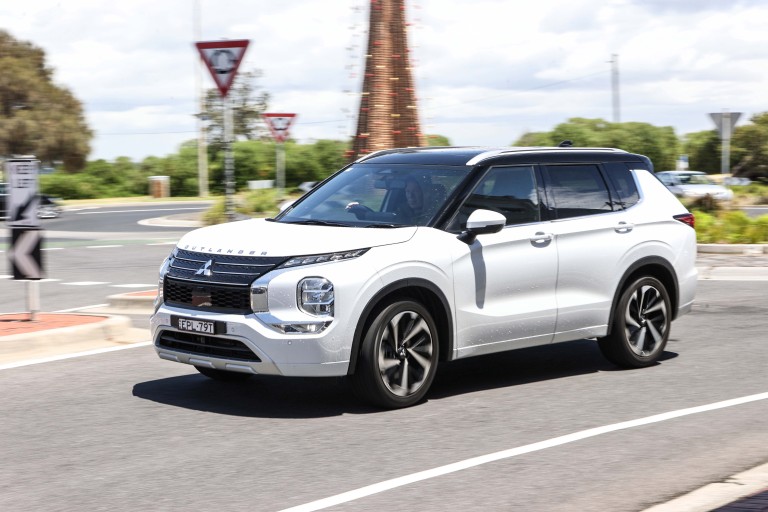
The Outlander beat its Nissan cousin to the Aussie market by more than a year and in that time its chunky SUV styling, appealing pricing and seven-seat capability has seen it cleave an 11 percent slice of the segment all for itself.
The Subaru Forester is another Japanese entrant that trades heavily on blocky aesthetics and the promise of off-road competence, though it was one of the SUVs most affected by supply shortages last year. A quick glance at how many late-model Foresters are getting around should tell anyone that Subaru’s mid-size SUV knows how to appeal to the audience.
No surprises that there’s a Toyota RAV4 and a Mazda CX-5 in our little battle royale. Both are sales Goliaths that the rest of the field will be looking to strike down, with the Toyota shaping up as a thrifty Cruiser Hybrid FWD while the Mazda’s reputation as a driver’s SUV sees it arrive with a hard-hitting turbo 2.5 under the bonnet.
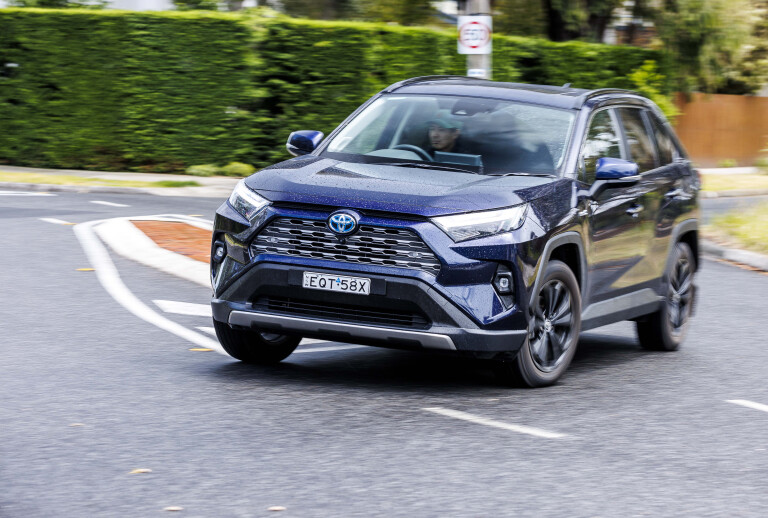
Like the Nissan and Mitsubishi, Kia’s Sportage and Hyundai’s Tucson are twins under the skin. Does that mean they’re interchangeable? We’re throwing the diesel version of the former and the turbo-petrol version of the other into the ring to see which one could rise to the top.
And lobbing in as something of a wildcard entrant – as the only contender not to clock five-figure sales in 2022, if hardly a sales minnow when the seven-seater Tiguan Allspace is factored in – is the Volkswagen Tiguan.
Available to us as a circa-$60K 162TSI R-Line for this test, it does pose a couple of intriguing questions: to what lengths does the go to justify its price premium; and, with the body of a shopping cart but the heart of a hot hatch in this spec, how much of a gap exists between the sporty-ish Tiguan (it’s no Tiguan R) and the rest of the pack on demanding roads.

Who is missing?
Keen market-watchers will notice some omissions that might surprise.
For one, where are the Chinese entrants like the MG HS or Haval H6? Or how about some French metal? Or maybe Honda’s CR-V?
Popularity breeds competition, as they say, and the mainstream mid-size SUV segment is now so crowded that we’ve simply attempted to cover off the most popular and most established nameplates in the segment at the circa-$50K mark.
So if you’re considering a medium SUV in 2023, the odds are that there’s going to be significant overlap between the cars on your shortlist, and the ones we’ve got here.

🧰 Which medium SUV is the cheapest to service and maintain?
Every SUV tested has incentives to get your servicing done at the dealer, but not every program is created equally.
We’ve compared what each car costs to run over three and five years, taking into consideration the average Australian travels around 13,000km annually in their vehicle.
The X-Trail, Forester, CX-5, Outlander, RAV4 and Sportage are all covered by capped-price servicing schemes. Comparatively, the Tiguan and Tucson offer the best value when you pre-pay for their service plans at time of purchase (in three or five year increments).
As for intervals, all vehicles will go for 12 months between services, but the Tucson (10,000km) and Forester’s (12,500km) shorter intervals are less attractive.
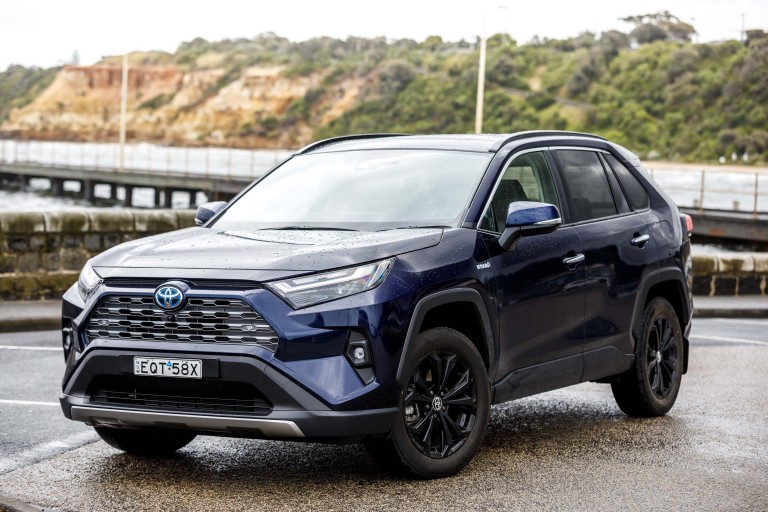
Frustratingly, despite sharing an engine and drivetrain with the Mitsubishi Outlander, the X-Trail also requires a trip to the mechanic every 10,000km rather than 15,000km and costs a whopping $1461 more to maintain over a five-year period.
Servicing costs
| Model | Service interval | 3-year/39,000km cost | 5-year/65,000km cost |
|---|---|---|---|
| RAV4 | 15,000km/12 months | $780 | $1300 |
| Outlander | 15,000km/12 months | $947 | $1595 |
| Tucson | 10,000km/12 months | $1276 | $1980 |
| CX-5 | 15,000km/12 months | $1296 | $2460 |
| Sportage | 15,000km/12 months | $1325 | $2512 |
| Tiguan | 15,000km/12 months | $1650 | $2950 |
| Forester | 12,500km/12 months | $1387.25 | $2674.64 |
| X-Trail | 10,000km/12 months | $1364 | $3056 |
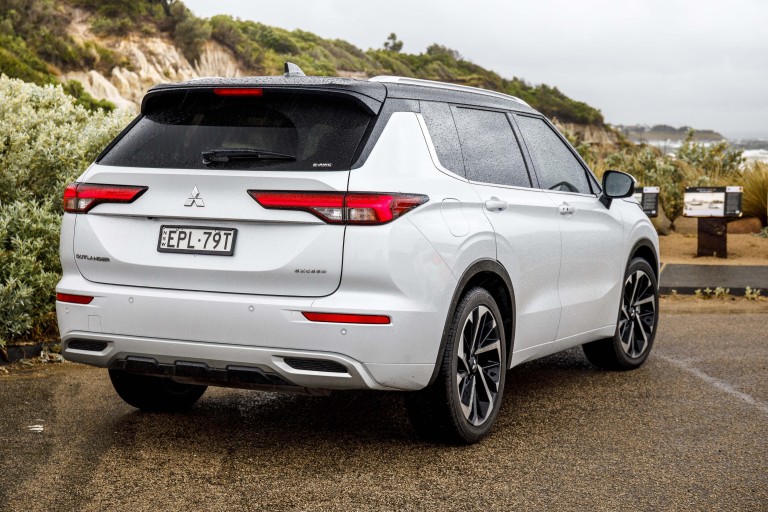
⛽ Which medium SUV uses the least fuel?
We collected real-world fuel figures on all our contenders and have ranked them in the table below. Each SUV was brimmed before embarking on our lengthy road-test loop (an even mix of urban, highway and country roads) and then re-filled once the course was completed. Cars were also driven on the same day in the same conditions to ensure our figures are as fair and as accurate as possible.
Perhaps unsurprisingly, the Toyota RAV4 hybrid takes an easy win while the grunty Mazda CX-5 trails in last. The table below shows how each SUV compares in the ADR 81/02 cycle and our tested figures, with Tiguan and Outlander getting closest to their official ratings on test.
As in servicing, the X-Trail differs markedly from Outlander, its ADR rating 0.3L/100km better and requiring premium 95 RON unleaded despite developing the same power and torque on paper.
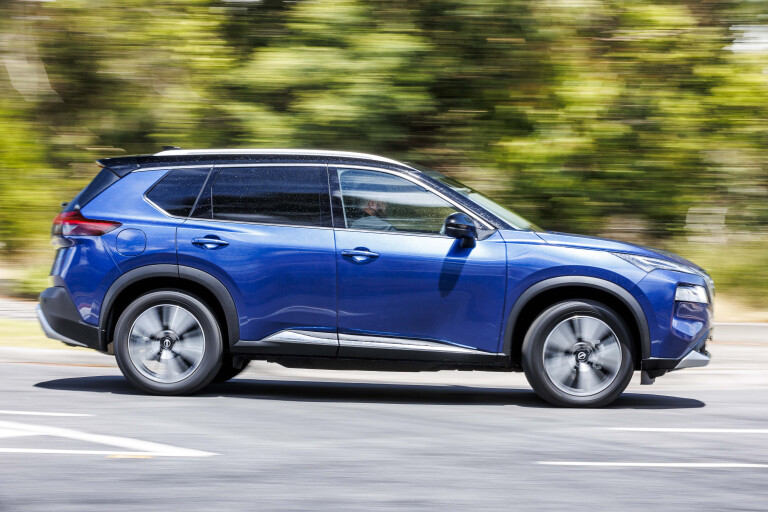
Fuel use
| Model | Tested economy | ADR 81/02 rating | Percentage difference | Fuel type |
|---|---|---|---|---|
| RAV4 | 7.4L/100km | 4.7L/100km | 57% | 91 RON/E10 |
| Sportage | 8.0L/100km | 6.3L/100km | 27% | Diesel |
| Outlander | 9.7L/100km | 8.1L/100km | 20% | 91 RON/E10 |
| X-Trail | 9.8L/100km | 7.8L/100km | 26% | 95 RON |
| Forester | 10.0L/100km | 7.4L/100km | 35% | 91 RON |
| Tucson | 10.2L/100km | 7.2L/100km | 42% | 91 RON/E10 |
| Tiguan | 10.5L/100km | 8.5L/100km | 24% | 95 RON |
| CX-5 | 11.3L/100km | 8.2L/100km | 38% | 91 RON/E10 |
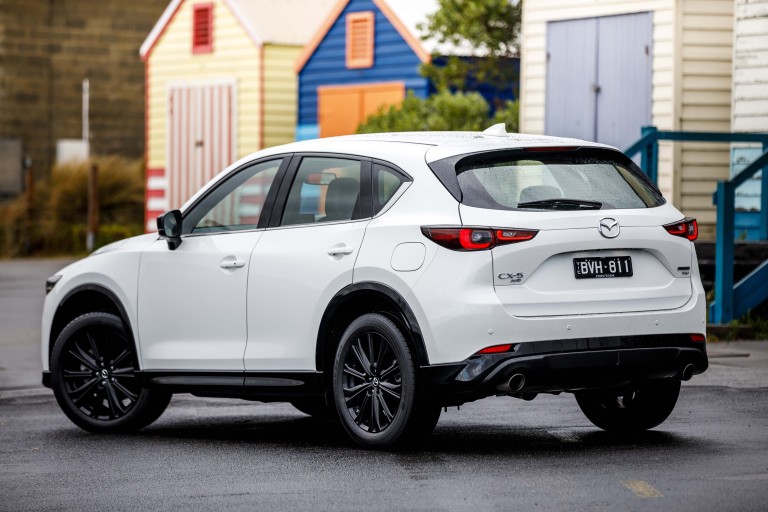
🛡️ Which medium SUV has the best warranty?
There are three stand-outs when it comes to peace of mind in this test.
Kia Sportage: 7 years/unlimited kilometres
Roadside assist is complimentary for 12 months, but this extends to eight years if the vehicle is serviced on time. Navigation/audio visual equipment only covered for three years.

Mitsubishi Outlander: 5 years/100,000km
Mitsubishi’s ‘Diamond Advantage’ runs for 10 years/200,000kms, but it’s more a five-plus-five than true 10 year warranty as it requires the vehicles to be serviced exclusively at an authorised Mitsubishi dealer. Complimentary roadside assist is included for 12 months.
Toyota RAV4: 5 years/unlimited kilometres
Providing servicing is completed on time the engine/drivetrain is covered for up to seven years, and the hybrid battery 10 years. No roadside assistance included.
Warranty period & roadside assistance
| Model | Warranty period | Roadside assist |
|---|---|---|
| Sportage | 7 years/unlimited kilometres | Up to 8 years |
| Outlander | 5 year/100,000km OR 10 year/200,000km | 12 months complimentary |
| RAV4 | 5 years/unlimited kilometres; 7 years unlimited kilometres (powertrain) | Not included |
| CX-5 | 5 years/unlimited kilometres | 5 years complimentary |
| X-Trail | 5 years/unlimited kilometres | 5 years complimentary |
| Forester | 5 years/unlimited kilometres | 12 months complimentary |
| Tiguan | 5 years/unlimited kilometres | 12 months complimentary |
| Tucson | 5 years/unlimited kilometres | 12 months complimentary |

🧳 Which medium SUV has the best boot?
A good SUV is a useful one and having a boot large enough to fit a modern family’s cargo is a must have for many SUV buyers. But a good boot goes beyond how many litres of stuff it can swallow.
Thoughtful touches like bag hooks, floor dividers and sliding second rows can elevate an averagely sized boot into a genuinely useful one. Here we’ve ranked each contender purely from a pragmatic point of view and ordered them from best-to-worst for size, features and ease of use.

1) Volkswagen Tiguan
With 615 litres of seats-up cargo space the Tiguan easily outguns everything else, but note that that number is only achieved with the sliding second row is all the way forward. Seats-down capacity is 1655 litres.
There are remote release handles for the rear seatbacks for extra convenience, a pair of stout shopping back hooks for smaller grocery runs, a 12-volt power outlet, a two-position floor height, 40/20/40 split rear seatbacks, sturdy steel tie-down points and a pair of side pockets for stowing small stuff. The spare tyre is a space-saver, however.
Non-retractable hatchback-style cargo cover is a pain if you need to remove it to carry oversized items, as there’s no convenient space in the cabin to stow it. Also: a power tailgate is a cost option, which is pretty rude at this end of the price spectrum.
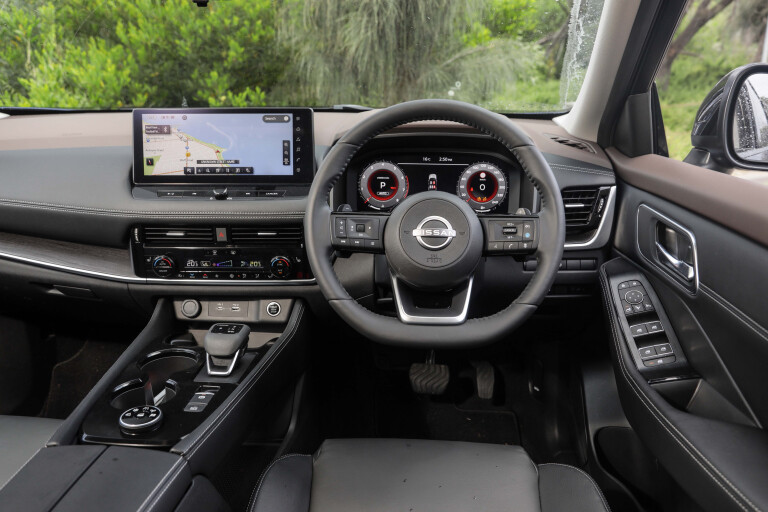
2) Nissan X-Trail
The X-Trail’s boot space measures in at 585 litres with the seats up when in five-seat non-hybrid form, a generous number. Not only that, but its removable and repositionable two-piece floor allows that space to be divided up into chunks to help separate cargo or keep smaller loads secure, or just provide a useful under-floor option for flat or soft cargo that you don’t want mixing with bigger things.
The 40:20:40 split seatback provides a centre passthrough, the retractable cargo blind has its own storage spot under the boot floor, there’s a 12-volt power outlet and the walls are trimmed in carpet to reduce noise from shifting luggage. A space saver spare is located beneath the boot floor, and a power tailgate is standard on the Ti grade.
No bag hooks or seatback release handles are two notable omissions, though. If the X-Trail had both, it would arguably have equalled – or perhaps even bettered – the Tiguan.

3) Toyota RAV4
The RAV4 might miss out on the bag hooks and seatback releases of the Tiguan, not to mention the X-Trail’s versatile floor panels, but its seats-up capacity of 580 litres is still a healthy number. With a lengthy boot floor it also allows easier carriage of bulky stuff like prams and camping fridges – a 12V outlet being available for the latter.
Retractable cargo blind can be removed if you want to unlock even more capacity (seats-down figure is 1690L), while the removable floor panel can be mounted at two different height settings or flipped over to protect its carpeted side from dirty or wet cargo.
There’s only a space-saver spare under the boot floor and the 60/40 split-fold rear seat doesn’t have a pass-through for long cargo.
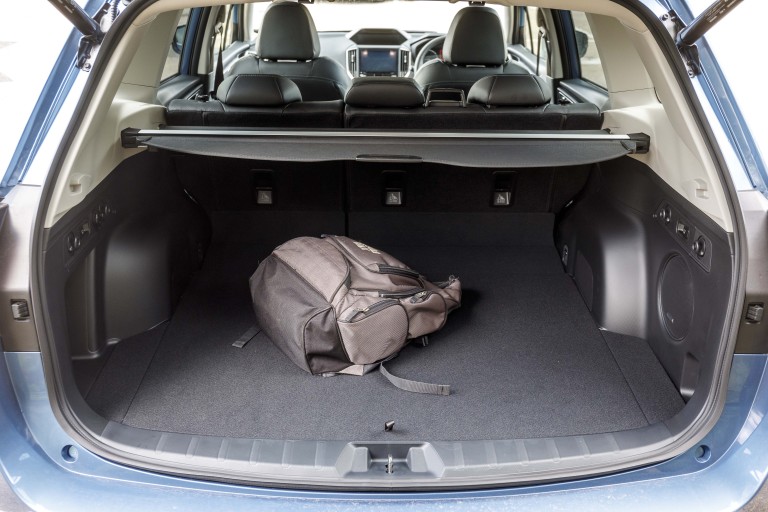
4) Subaru Forester
Forester’s 509L boot area isn’t the most commodious here, but it’s highly usable thanks to practicality-boosting features like four bag hooks, a power tailgate and electronic releases for the rear seats.
There’s no under-floor luggage space, but you will find a full-size spare wheel.
Unlike some other rivals, the Forester’s boot length is a little too short for a modern pram to fit lengthways – you’ll need to load it in sideways, which is a little more cumbersome. There’s also no cargo passthrough in the 40:60 split rear seats.
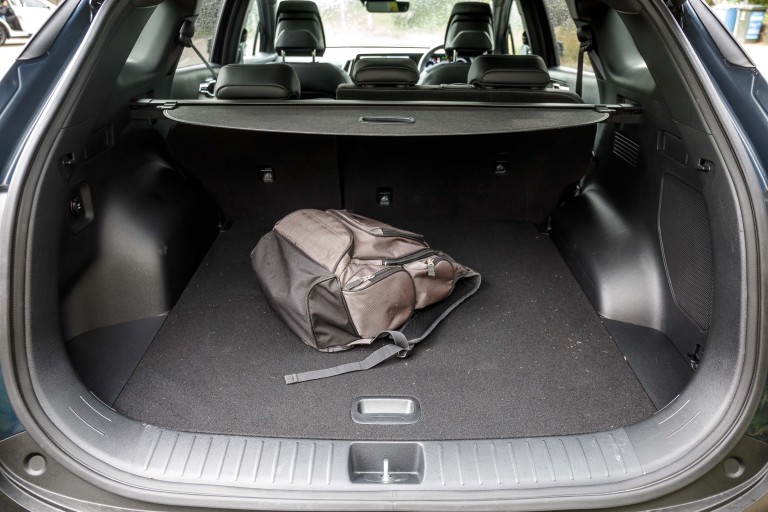
5) Kia Sportage
At 543 litres with the seats up (1829L with them folded down), the Sportage is about middle of the pack for cubic capacity, but goes a step further than most rivals by providing a hands-free power tailgate function at the SX+ and GT-Line grades
Some additional quality-of-life improvers include remote seatback releases, a 12-volt power outlet and provision for a cargo net, but curiously the Sportage’s shopping bag hooks are located in the passenger area, on the back of the front seats.
The boot sides are trimmed in hard plastic that marks up easily from sharp-edged luggage and there’s no pass-through portal in the rear seats, but there is at least a full-size alloy spare wheel under the Sportage’s boot floor.
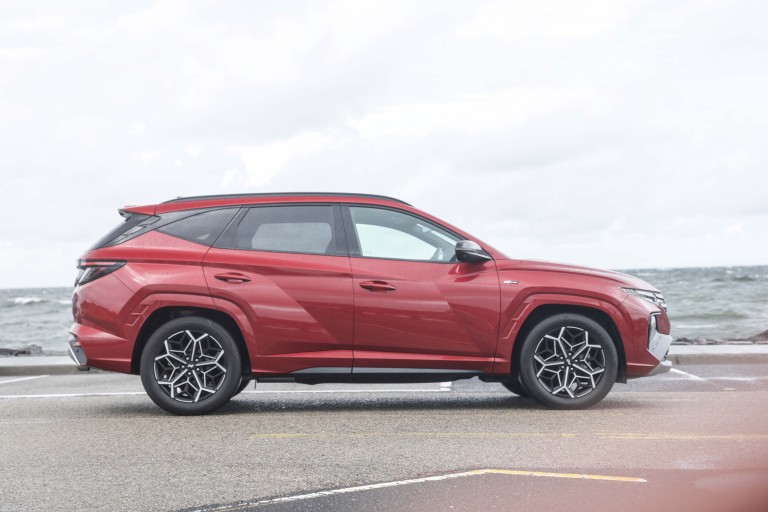
6) Hyundai Tucson
Though sharing the Sportage’s underlying structure, the Tucson’s cargo space still measures in with slightly different numbers. With 539 litres on offer with the rear seats raised it’s just four litres shy of its Kia cousin, but with 1860L available when you fold those 60:40 split seats down the Tucson becomes one of the most capacious contenders in this group.
Otherwise, the Tucson offers a very similar boot space to the Sportage, with the same features like a hands-free power tailgate, 12-volt outlet, luggage net, remote seatback releases and full-size spare alloy wheel.

7) Mitsubishi Outlander
The order may have been different if we didn’t have the seven-seater on test, but the three-row Outlander provides just 477 litres of luggage space when the two rearmost seats are stowed and a sub-500L number is a bit of a handicap in this crowd. It’s the price paid for a little extra passenger flexibility.
With third row raised, bank on only fitting a few backpacks or a modest amount of shopping bags behind them.
No bag hooks back here, and the spare wheel is a space saver – miraculously squeezed under the third row seat mechanism.
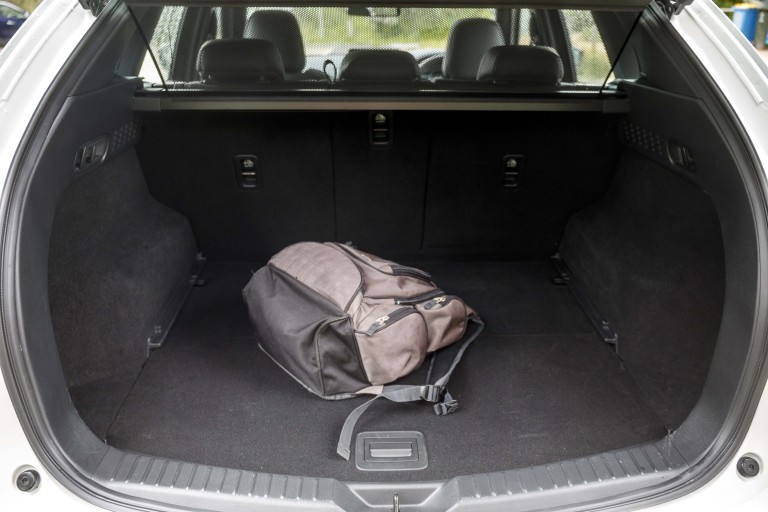
8) Mazda CX-5
With just 442 litres of seats-up luggage room and 1342L with the back seats folded down, the CX-5 is firmly in last place here. The floor can be adjusted to two different heights, but there’s just a handful of centimetres difference so the under-floor stowage is good for posters, pancakes, and not much else.
A power tailgate is standard on the GT SP grade, the retractable cargo blind is the best in the group, seatback release handles are provided and a 12-volt power outlet is provided in the load area, but ultimately this is one of the smallest boots in class.
A temporary steel spare wheel is located under the boot floor.

Mini matchup: Boot space
| Model | Second row up | Second row flat | Rear seat split |
|---|---|---|---|
| Volkswagen Tiguan 162TSI R-Line | 615L | 1655L | 40/20/40 |
| Nissan X-Trail Ti | 585L | Figure not available | 40/20/40 |
| Toyota RAV4 Cruiser Hybrid | 580L | 1690L | 60/40 |
| Subaru Forester 2.5i-S | 509L | 1768L | 40/60 |
| Kia Sportage GT-Line diesel | 543L | 1829L | 40/20/40 |
| Hyundai Tucson Highlander 1.6T N-Line | 539L | 1860L | 60/40 |
| Mitsubishi Outlander Exceed Tourer | 478L | 1473L | 40/20/40 |
| Mazda CX-5 GT SP | 422L | 1342L | 40/20/40 |
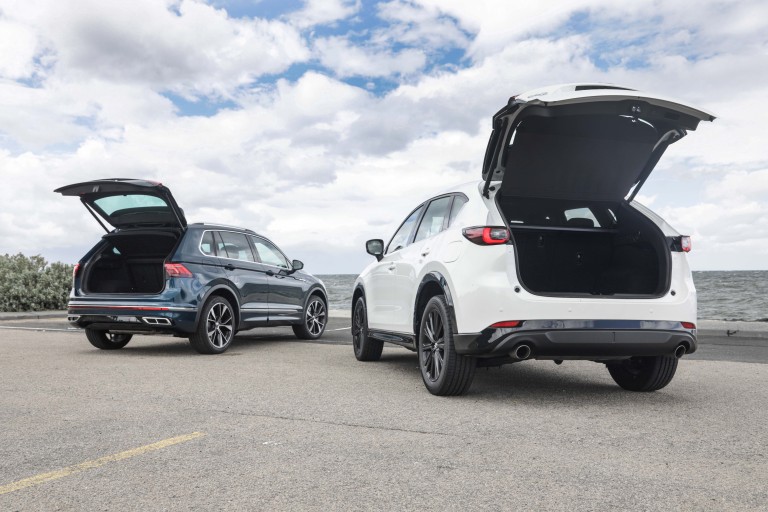
👨👩👧👦 Which medium SUV is best for family duties?
In assessing the family-friendliness of this group, we looked at key attributes families think about when buying a car: space, level of features and amenity available (USB ports, rear air vents, cupholders, window blinds etc) and also how wide the rear doors open and if they hold themselves still when they are.
Another key factor is how easy it is to fit a child seat. We fitted three types of seats to each SUV including a rear-facing capsule (for babies up to six/12 months), a convertible (0-4 years-old) with Isofix anchors, which can be used front- or rear-facing, and a booster seat for children aged roughly from four to seven.
Here’s how our group of contenders fared from most impressive to least.

1) Nissan X-Trail
The new-generation X-Trail stood out from the pack in this discipline. Of our eight contenders it had the widest-opening doors – allowing for plenty of room to get people, child seats or kit in and out – and its rear seat is bursting with features including two map pockets, three-zone climate control, easily wiped-down leather seats and two USB ports – one type A and one type C.
Rear seat room is also generous, the second row slides which allows you to vary passenger room and boot space, and storage is decent thanks to large door pockets.
Fitting child seats was a doddle, too, thanks to conveniently-accessible Isofix anchors, easily-adjustable headrests and a retractable parcel shelf with a huge gap for feeding the top tether belt through – though we prefer tether hooks that you don’t have to fiddle inside the lining of the back of the rear seats to find.

2) Kia Sportage
The Kia Sportage scores well for family duties and isn’t far behind the X-Trail in a number of key areas. Like the Nissan it has a large boot, lots of legroom for passengers front and rear, leather seats, second row cupholders, a retractable parcel shelf, controllable rear air vents and two USB outlets.
Where it lacks the robust practicality of the X-Trail is in areas such as storage space in the rear doors (which can’t fit a bottle), a tighter door aperture, no cubbies in the boot and tucked away Isofix anchors that can be a pain to locate and connect.
In other ways however it offers some finer touches its rivals miss out on, such as tablet holders on the front seat-backs and additional coat/jacket holders.
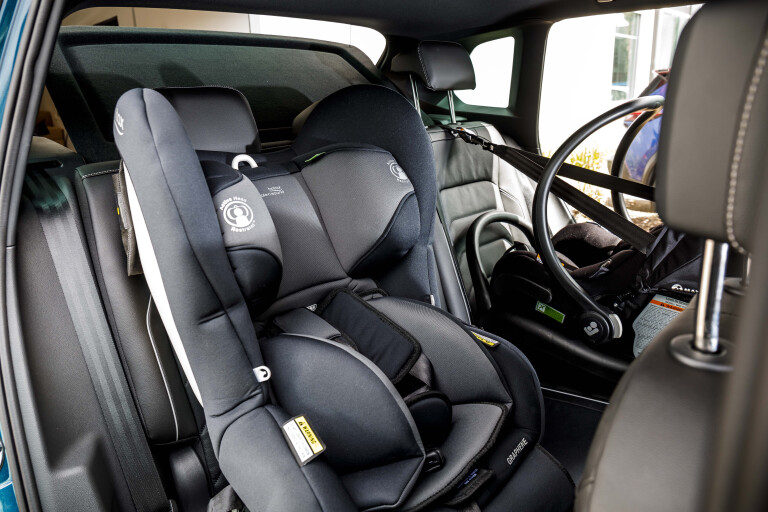
3) Subaru Forester
Subaru’s SUV mainstay continues to attract parent buyers for its excellent use of space and no-thrills rugged aesthetic. In most ways its family features bear a striking resemblance to the Sportage’s, but with pros being more storage space in the rear doors and room for the front passenger when a child seat is fitted.
It was the only vehicle in the bunch where we didn’t need to bring the front seat forward at all to accommodate a rear-facing capsule.
Negatives include split map pockets which would be able to hold smaller items but not larger ones, USB-A ports rather than the faster type Cs, and a more squished experience in the back for an adult sitting between two child seats when compared to the Sportage and X-Trail.
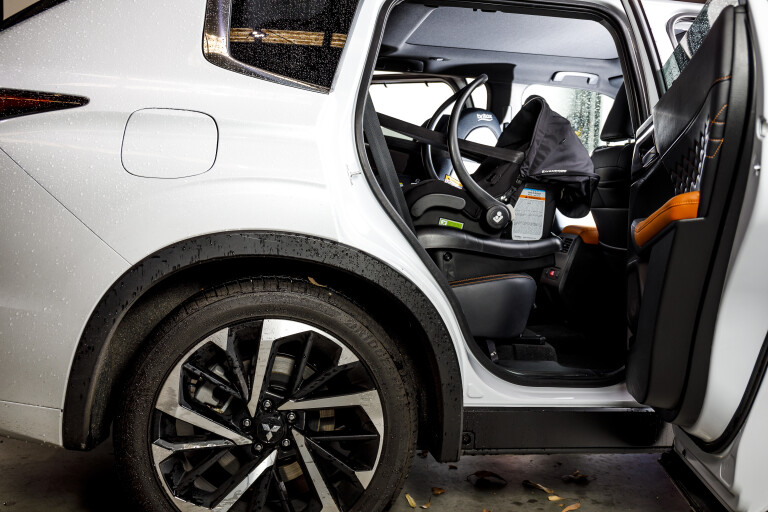
4) Mitsubishi Outlander
The Outlander shares its platform and basic dimensions with the Nissan X-Trail, so much of the core goodness that made the Nissan our pick for family duties also applies here. Its rear bench slides and there’s a healthy smattering of desirable features including two map pockets, two USB ports (1 x Type A and 1 x Type C), rear air vents with temperature control and soft leather seats.
And given this is the flagship Exceed Tourer model grade you even score features the Nissan doesn’t have like standard rear window blinds and heated rear seats. Legroom for front passengers is also very good when a rear-facing child seat is installed behind.
Where the Outlander fell down is access to its rear seats is quite tight and far inferior to the Nissan. The X-Trail’s rear doors open wide to 90 degrees but the Mitsubishi’s only open to around 60-70 degrees.
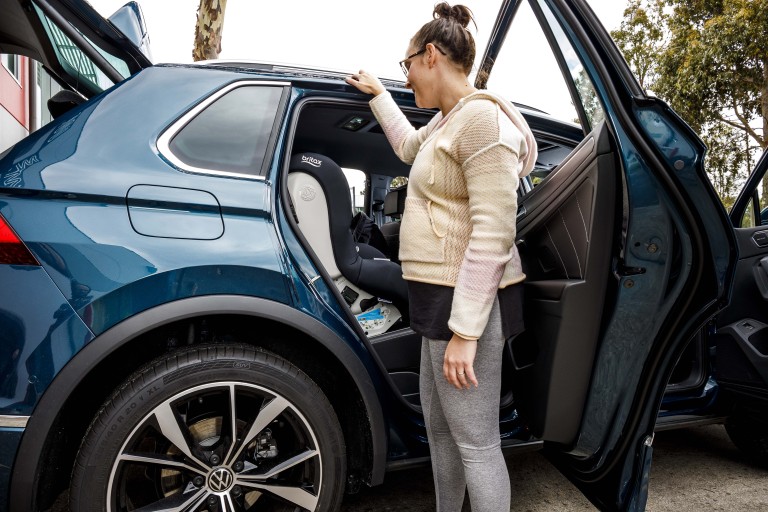
Equal 5) Volkswagen Tiguan
It won our ‘best boot’ category and there’s lots to like about the Tiguan for family duties, too. The rear doors open nice and wide, the flocked door pockets are generous, the second row slides and there are rear cupholders and air vents.
There’s only one USB-C port, though, and fitting child seats is made more difficult by an annoyingly hard parcel shelf which needs to come out to get the top tether adjusted properly.
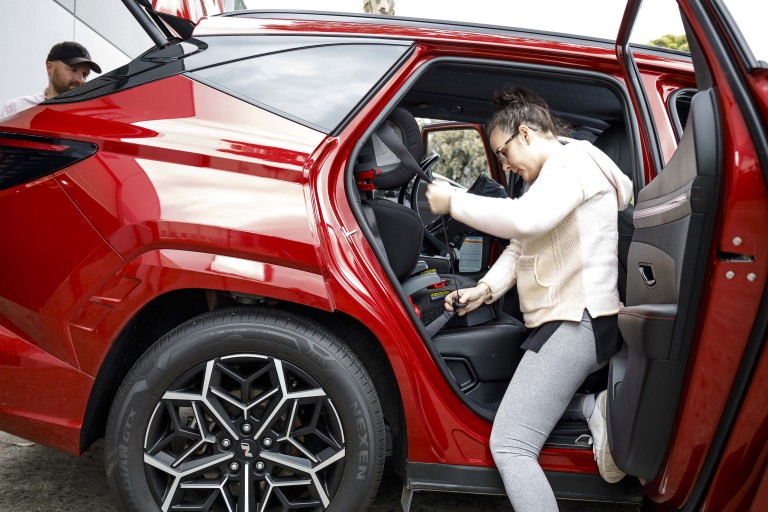
Equal 5) Hyundai Tucson
Pretty much equal to the Tiguan thanks to wide door apertures and a roomy boot at 539L (no cubbies though), while back seat passengers also score rear climate control and two USB ports.
But Tucsons’s door pockets are smaller and its map pockets are made of a cheaper net material which could be prone to tearing and struggle to hold small loose items. Legroom for the front passenger is decent but for any adult unlucky enough to end up in the middle back seat things are very tight – the most uncomfortable on test by far.
Fitting the top tether on child seats is also difficult due to a narrow gap between the back of the second-row seats and the retractable parcel shelf.
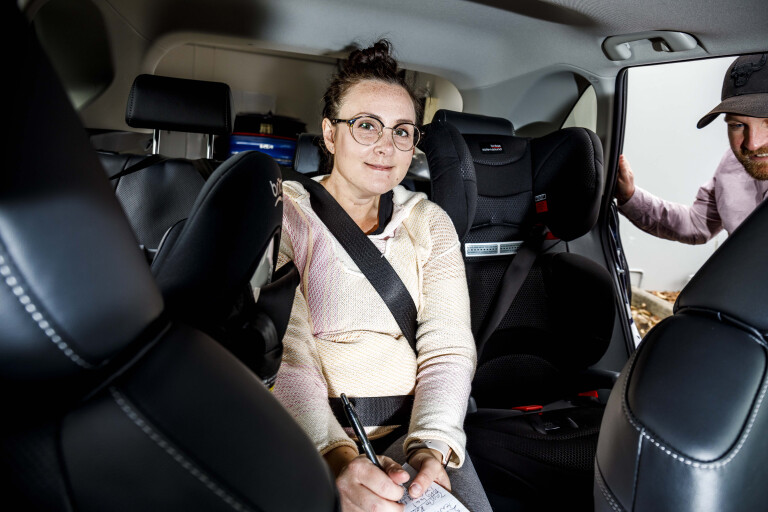
Equal 6) Toyota RAV4
A surprisingly low finishing spot for the RAV4 given its large boot and roomy rear seat but its door pockets are on the small side and fitting child seats is difficult due to Isofix anchor points and top tethers that are tricky to reach. Adult room for front passengers or in between child seats is also severely cramped.
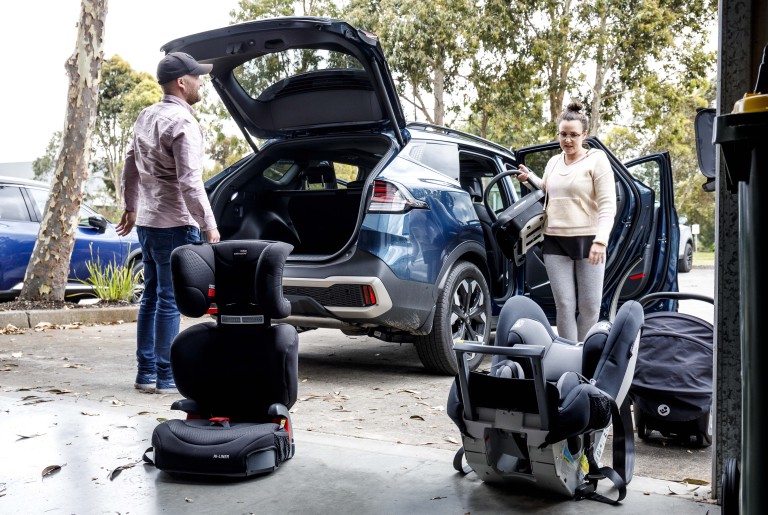
Equal 6) Mazda CX-5
Space, or lack thereof, is the primary reason Mazda’s popular mid-sizer finishes last in this discipline. It has the smallest boot on test, its rear door aperture is narrow, rear-seat room is on the tight side and its lower roof line also compromises space and rear-seat access.
Plus points include two USB-A ports, two map pockets, rear air vents, leather seats, a retractable parcel shelf and easy access to Isofix and top tethers alike. In fact, from our own experience, as well as experts at Baby Bunting, we’ve found Mazdas are some of the easiest cars to install child seats in.
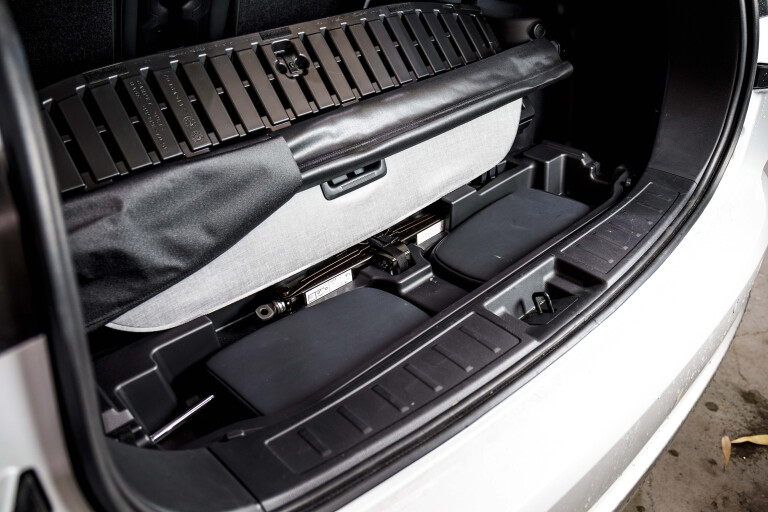
🛣 What are they like to drive?
They might spend most of their time trundling the kids to school but a good family SUV should also be well-sorted to drive, both in the city and on the open road.
For this section each contender was driven on an urban road loop and also on a challenging country road littered with nasty mid-corner bumps, tight corners and sharp elevation changes.
Comfort, body control and a ride/handling balance that strikes a sweet balance between driver involvement and everyday usability were what our road testing team was looking for. Here’s how our field measured up for dynamics.

1) Volkswagen Tiguan
If you’re a keen driver, the Tiguan is easily the pick of this group. On our chosen ribbon of bumpy, twisting tarmac, it’s in another league for pace, grip, control and driver involvement thanks to its punchy 162kW/350Nm turbo engine and taut body control.
The calibration of its DSG transmission, confidence inspiring brake pedal and crisp and responsive 2.1 turn lock-to-lock steering are also standouts in this class.
Comfortable ride, too, thanks to adaptive dampers that iron out all but the nastiest of bumps when set to their Comfort or Normal setting. And that’s despite huge 20-inch alloys wrapped in 255/40 series Continental Sportcontact 5 tyres.
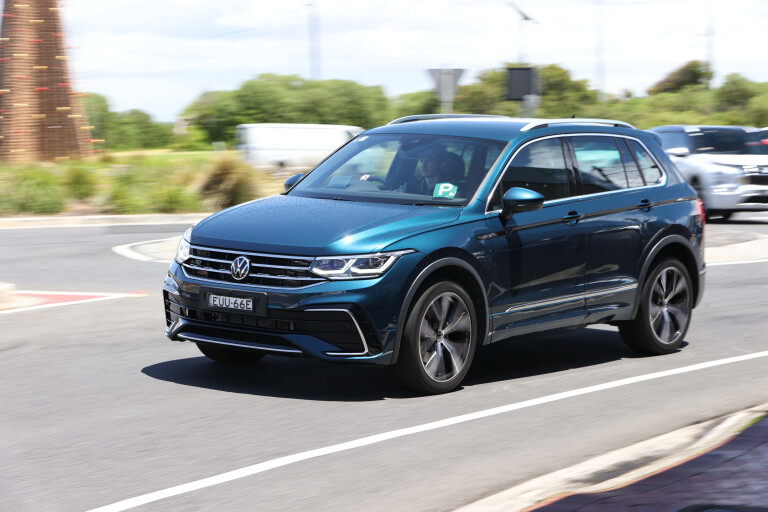
The Tiguan’s engine also used 7 per cent less fuel on test than the Mazda CX-5 and nearly as little as the significantly slower Forester (though Tiguan does require 95 RON). It’s also a refined engine at cruising pace, with a pleasing angry bark at high RPMs.
With its upright driving position, low dash and generous glass-house the Tiguan has excellent visibility in all directions. It also demonstrated the most effective lane-keep assist and adaptive cruise control systems on test.
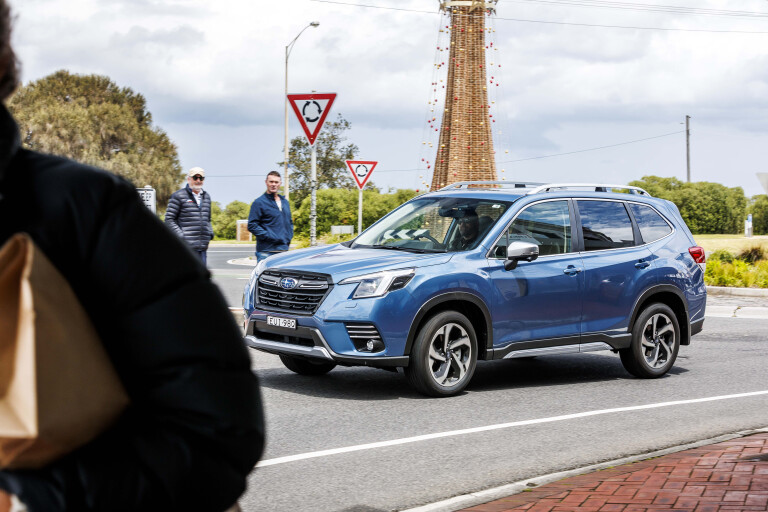
2) Subaru Forester
Surprised to see the Forester so high up for ride and handling? Us too, honestly. On paper the Forester’s powertrain and chassis combo don’t scream ‘driver’s SUV’ but on our road loop it was a genuine surprise.
Okay so the atmo 2.5-litre boxer is pretty limp with just 136kW/239Nm but the Forester is a hoot to hustle up a demanding section of road thanks, mostly, to its comparatively low weight of 1576kg. In this company it feels lithe and agile and there’s genuine chassis talent and engagement to explore once you start to reach the impressively high grip limits offered by the 225/55 R19 Bridgestone Dueller HP Sport tyres.
It could definitely handle more grunt, though. Why hasn’t Subaru slipped a WRX-spec turbo boxer into this Forester yet? Great question.

3) Mazda CX-5
The CX-5 is renowned for its sharp handling and this latest update has only refined the recipe thanks to revised damper settings and improvements in body rigidity. The naturally weighted steering is also a highlight and there’s loads of oomph on tap from the 170kW/420Nm 2.5-litre turbo petrol.
Not only is it the most powerful engine in this test but it sounds great and pairs beautifully to a six-speed automatic that allows you to harness its gutsy and flexible mid-range. Grunt and only six ratios comes at a cost, though, the CX-5 returning an as-tested fuel economy figure of 11.3L/100km.
Like its chassis, the CX-5’s Safety systems have incrementally improved. The lane-keep assist is subtle yet effective, as is the adaptive cruise control. The CX-5 may no longer be the sportiest steer here, but it strikes an excellent balance between the nearly-too-soft but adjustable Forester, and the tied down Volkswagen Tiguan.
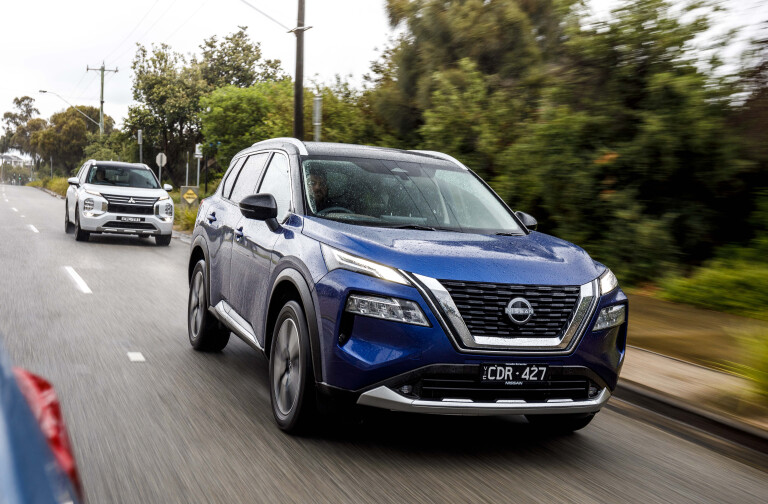
4) Nissan X-Trail
Dynamically the X-Trail is solid rather than excellent. Nissan has opted for a ride/handling balance that favours comfort over agility, and while that delivers a calm and serene experience around town, on our demanding road loop the X-Trail was let down by pronounced bodyroll and intrusive ESC interventions.
The light steering also feels aloof with some of our roadtest team describing it as ‘video game like’ in its lack of connection to the road.
So a driver’s SUV it is not but what the X-Trail gives away in outright dynamics it makes up for in day-to-day comfort and refinement.

5) Mitsubishi Outlander
More fun to drive on a twisty road than the closely related X-Trail thanks to higher grip levels, a keener and more responsive front axle and a nicely sorted all-wheel drive system. Meatier steering than the Nissan, too, though it still doesn’t offer much in the way of feedback.
But it’s the Outlander’s sharp and unforgiving ride that sees it tumble down the order in this category. Top-spec Outlanders roll on 20-inch wheels as standard,
and they don’t only feel heavy and enormous but they keenly transmit lumps and bumps into the cabin. Sharp bumps can jolt unpleasantly and on our challenging road loop the Outlander was one of the firmest to drive hard.
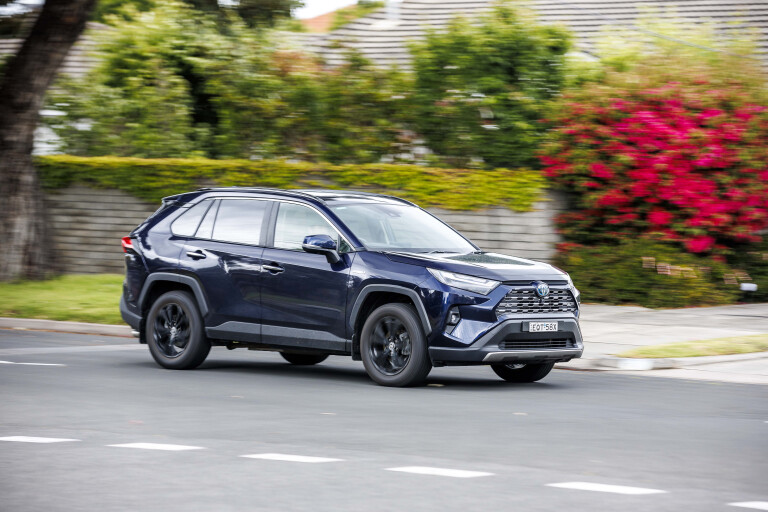
6) Toyota RAV4
Broadly capable but fairly unexciting is perhaps the easiest way to summarise the RAV4’s dynamics. Like the X-Trail this is a family SUV that clearly favours ride comfort and urban road manners over driver involvement but that’s not to say it feels out of place on a twisty country road.
Road holding is satisfactory and despite its long-travel suspension there’s enough damping force to rein in the RAV4’s 1700kg mass over more demanding sections of blacktop. And while it has an obvious focus on economy, the 160kW hybrid powertrain can supply a gratifying level of shove when pushed.
It’s no athlete, mind, but on a country road the RAV4 isn’t that shabby either.

7) Hyundai Tucson
If this section was judged solely on outright grip and roadholding, there’s little doubt the Tucson would have finished higher up. Hurl it at a twisty section of road and there’s a surprising degree of cohesion to its dynamics courtesy of steering that’s accurate and naturally weighted, strong brakes and decent body control.
The 132kW/265Nm 1.6-litre turbo and dual-clutch gearbox also deliver their best work at higher speed and combine to deliver a powertrain that feels gutsy and decisive on the open road. But it’s around town where the Tucson struggles a touch. At low speed the powertrain combo can be frustratingly slow and jerky, not to mention thirsty.
And the Tucson’s turning circle felt more cumbersome than other SUVs in this test, with the Kia often requiring three-point turns around tight round-a-bouts.
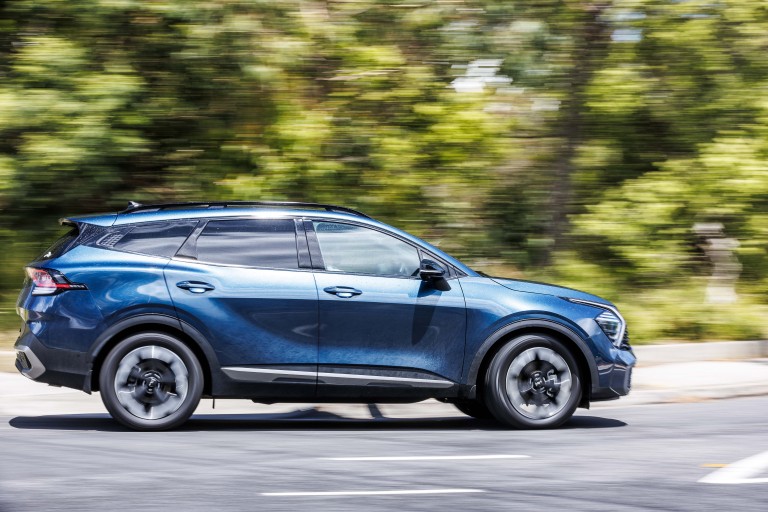
8) Kia Sportage
Finishing this section in last spot is something of a shock for the Sportage given it has a local suspension tune and is powered by a grunty and refined 2.0-litre diesel. With 137kW/416Nm under its hat, the Sportage’s diesel pairs nicely with an eight-speed automatic and is actually the powertrain we’d recommend across the Sportage/Tucson model ranges. So why the lowly finishing spot?
How the Sportage fared on our twisty and challenging road course is the primary reason. Despite the local tuning, the Sportage’s body control was the most wayward of this group and over bigger bumps it felt underdamped as it struggled to rein in sharp vertical movements.
The trade off is a ride that feels comfortable and compliant around town but in this company, the Sportage trails for outright dynamics.
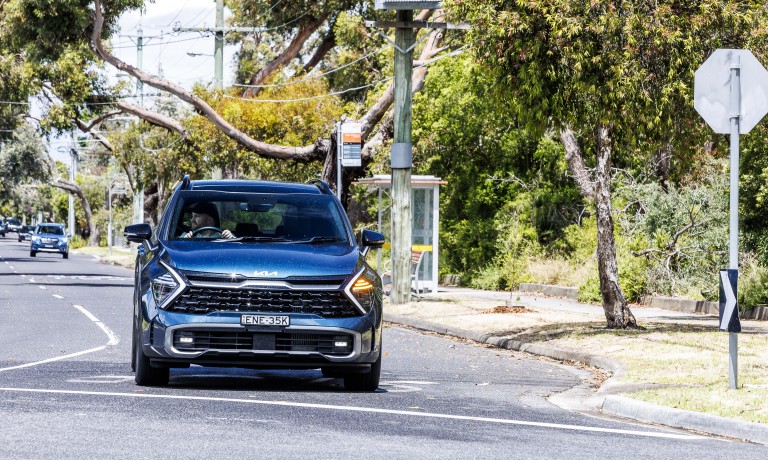
VERDICT: Which medium SUV do we recommend?
Nissan delivers a class leader… with a caveat attached
Australia’s mid-size SUV segment is now so competitive and our eight contenders are so closely matched that we've had to split hairs in some instances. It’s refreshing to report that, with such a large group of high-selling vehicles, there actually isn’t an SUV here we wouldn’t recommend. Popularity doesn't always equal quality.
Still, splitting hairs is what we do. And to help you make an informed decision about which $50K family SUV is best, we’ve ranked our contenders based on seven criteria: value, running costs, warranty/roadside assistance, boot space, rear-seat room/family duties, ride & handling, and tested fuel economy.
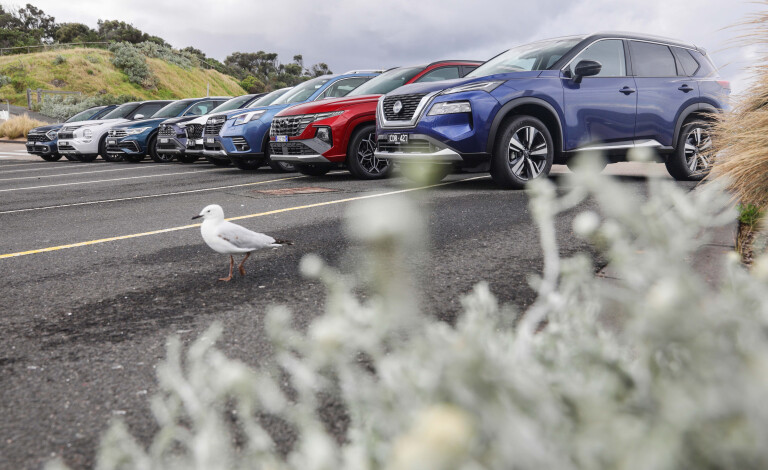
Averaging out how they performed in each discipline decided the final order, while allowing for some minor adjusting from our road-test team to set a clear hierarchy.
That’s why you’ll notice some SUVs carry the same score yet sit a place or two behind another contender. Value, how they drive, and overall polish are what split SUVs given the same mark.
A final point worth considering: this particular pecking order is for a specific price point. Venture either side of our $50K bracket and the mix of standard equipment, active safety systems and suspension tunes/wheel sizes is different enough to potentially alter the order.
We chose the $50K price point for this test because of its popularity. So, if you’re one of the thousands of Aussies shopping for a new family SUV, here’s how this group stacks up and why.

🥇 Winner: Nissan X-Trail Ti
A brilliant all-rounder and easily the best of this group for family duties thanks to rear doors that open to 90 degrees, a roomy/flexible rear seat, and a large boot that offers clever storage solutions.
Smooth and serene to drive around town, too, thanks to a ride/handling balance that favours comfort over agility. Middle of the pack for outright dynamics, though. And the 2.5-litre atmo engine/CVT combo is adequate rather than excellent.
Biggest drawbacks are its short servicing intervals and highish capped price servicing costs, but as an overall package the new X-Trail offers the most for family buyer.
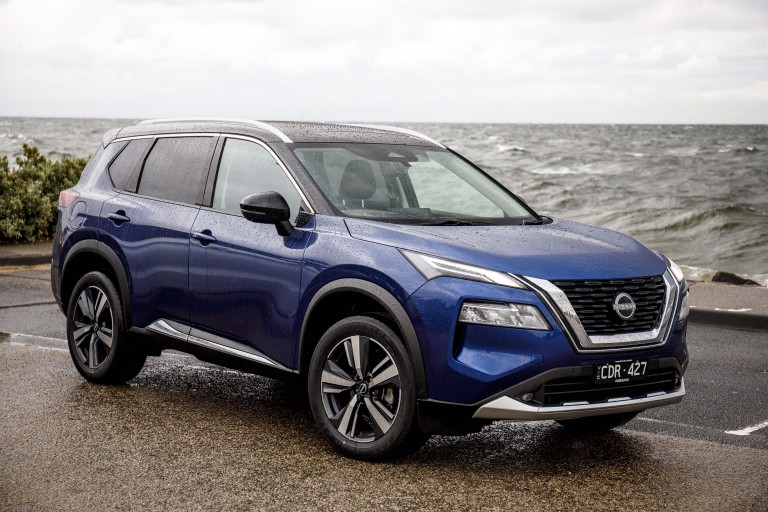
🥈 2nd place: Subaru Forester 2.5i-S
By far the cheapest of this group and also a hoot to drive on a twisty road. Cabin is starting to show its age but still holds its own against fresher rivals thanks to superb packaging, brilliant outward visibility and a surprising amount of room. Spacious rear seat and well-appointed boot also saw it score highly. Just nails the fundamentals. (But avoid the Hybrid.)

🥉 3rd place: Toyota RAV4 Cruiser Hybrid
Sales Goliath with good reason. Majors on value, space, equipment and efficiency with its hybrid powertrain returning the thriftiest ‘as tested’ fuel rating. Also commendably cheap to service.
Long wait times are a frustration, though, and keen drivers won’t find much to get their pulse racing. Plus, our test car had the old infotainment system which is leagues behind more modern-feeling rivals.
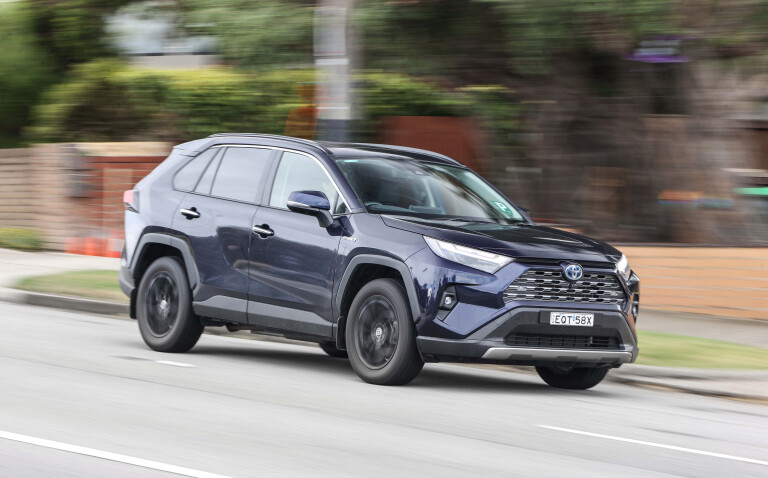
4th place: Kia Sportage GT-Line
A long 7-year warranty, strong efficiency credentials and a roomy rear seat/boot are the key reasons to buy a Kia Sportage. Looks sharp, too, thanks to its brave exterior design and the cabin execution feels a cut above its Korean sibling, the Tucson.
The diesel engine – the clear pick over the Sportage’s turbo-petrol drivetrain that would have pushed the Kia further down the order if tested here – is also a highlight thanks to its effortless torque, smooth operation and impressive refinement.
Dynamics not quite on the mark due to lax body control and unresolved suspension.
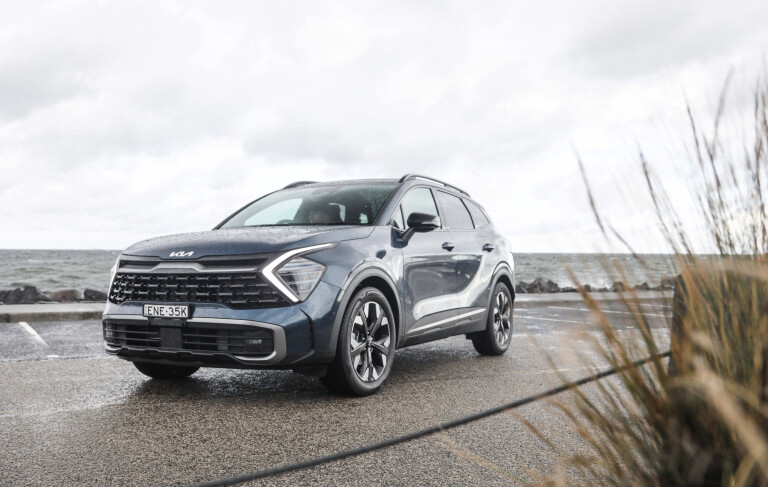
5th place: Mazda CX-5 GT SP Turbo
Mazda’s mighty mid-sizer might be getting on in years but constant improvement ensures it’s still easy to recommend. Keen drivers will appreciate the powerful 2.5-litre turbo engine and accurate steering, while the ride/handling compromise strikes a nice balance between engaging dynamics and everyday comfort.
Where the CX-5 stumbles is when it comes to packaging, with its tight rear seat and the smallest/least convincing boot of this group seeing it tumble down the order. The turbo engine is also pretty thirsty.
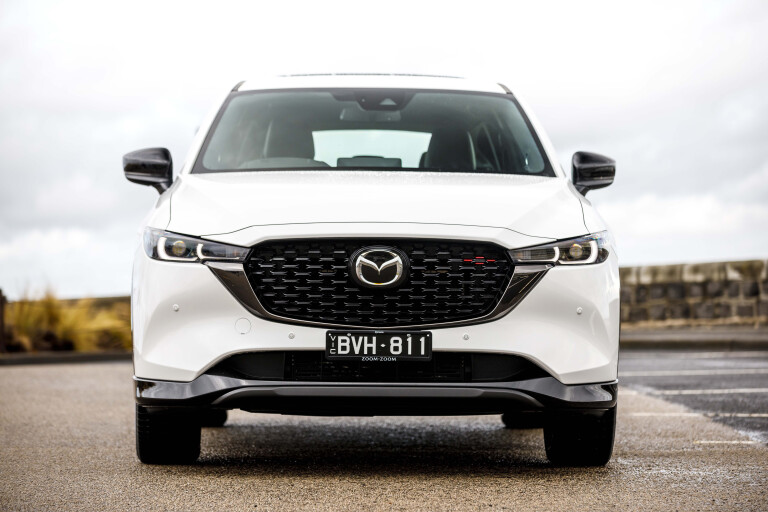
6th place: VW Tiguan 162TSI
Easily the pick of this group if you love driving thanks to a chassis that’s in a different league for agility, grip, communication and poise. Plenty of grunt, too, and despite being one of the smallest in this test the Tiguan’s rear seat space and large boot are impressive.
The lofty ‘as tested’ price of our optioned-up 162TSI R-Line test car hamstrung its value equation in this company, though.
A 132TSI Life ($46,690) might be a better match for budget-conscious buyers but the sheer popularity of the 162TSI R-Line shows many are willing to pay more for its extra polish, punch and luxury.

7th place: Mitsubishi Outlander
The sheer competitiveness of the mid-size segment is the main reason for the Outlander’s finishing spot rather than any great failing on Mitsubishi’s behalf.
The new Outlander is roomy, well equipped, fun to drive and the only one in the group to offer the flexibility of seven seats.
The X-Trail does more with the same ingredients, however, and while the Outlander is broadly capable, its inferior cabin storage compared with the X-Trail and sharp ride on 20-inch wheels were enough to relegate it to seventh.
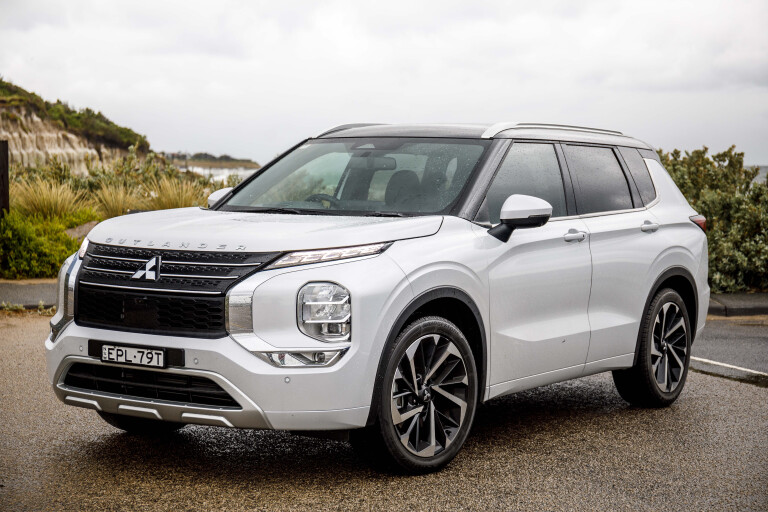
8th place: Hyundai Tucson Highlander
It’s rare for a last-place finisher to still be an SUV you’d recommend, yet that’s precisely the case with the Tucson. As a twin-under-the-skin to the Kia Sportage, which finished our test in fourth, the Tucson shares much of the same core goodness thanks to its spacious cabin, large boot, eye-catching design and impressive list of standard equipment.
Yet the Tucson’s 5-year warranty is shorter, its cabin ergonomics aren’t as user friendly, it’s costlier to maintain due to 10,000km service intervals, and its 1.6-litre turbo/dual-clutch combo isn’t as easy to recommend due to its higher thirst and jerkiness at low speed.
As with the Sportage, go for the diesel (and add another 0.5 to the Tucson’s score).

⏩ THE FAST VERSION: 'Pros & cons'
Nissan X-Trail Ti
Things we like
- Bigger, better and more premium than ever
- richly trimmed cabin offers loads of comfort and equipment
- comfy urban ride
- clever storage solutions
Not so much...
- Dynamics good rather than great due to vague steering/intrusive ESC
- short service intervals
- only mid-pack for economy and warranty coverage
Subaru Forester 2.5i S
Things we like
- Airy and spacious cabin
- Talented chassis for corner carving
- Cheapest of this group
Not so much...
- Uninspiring atmo engine
- Not as richly equipped as rivals
- Cabin design feeling its age
Toyota RAV4 Cruiser Hybrid
Things we like
- Feature packed
- Drinks the least fuel of this group
- Roomy cabin + big boot
- Cheap servicing
Not so much...
- Outdated cabin tech is off the pace
- Dour cabin ambience
- Capable rather than fun
Kia Sportage GT-Line
Things we like
- Impressive presentation
- Generous tech
- Big airy cabin
Not so much...
- Cheap interior materials to be found
- Lots of body roll
- Fidgety ride
Mazda CX-5 GT SP Turbo
Things we like
- Grunty turbo engine
- Comfortable yet controlled ride
- Slick six-speed auto
Not so much...
- No touchscreen
- Inconsistent cabin materials
- Least useful boot on test
Volkswagen Tiguan 162TSI
Things we like
- Outstanding body control
- Clever packaging
- Strong yet efficient petrol engine
Not so much...
- Expensive in this company
- Sparse cabin design
- Power tailgate optional!
Mitsubishi Outlander
Things we like
- Richly equipped and comfortable cabin
- Only contender on test with 7 seats
- 10-year warranty longest of our group
Not so much...
- Firm and compromised ride on 20s
- Amp petrol + CVT combo uninspiring
- Inferior packaging and storage compared with related Nissan X-Trail
Hyundai Tucson Highlander
Things we like
- Highlander specs heavy
- Cabin space and comfort
- N-Line styling
Not so much...
- Looks faster than it is
- Slow-witted dual-clutch
- Chassis upset by large bumps
Scores & ratings
| Ranking | Price as tested | Value | Running costs | Warranty + roadside assist | Boot space | Rear seat/family duties | Ride + handling | Tested fuel economy | Score/10 | |
|---|---|---|---|---|---|---|---|---|---|---|
| Nissan X-Trail | 1 | $51,990 | 3 | 8 | 5 | 2 | 1 | 4 | 4 | 8.5 |
| Subaru Forester | 2 | $46,340 | 1 | 7 | 6 | 4 | 3 | 2 | 5 | 8 |
| Toyota RAV4 | 3 | $48,200 | 2 | 1 | 3 | 3 | 7 | 6 | 1 | 8 |
| Kia Sportage | 4 | $52,720 | 5 | 5 | 1 | 5 | 2 | 8 | 2 | 8 |
| Mazda CX-5 | 5 | $52,485 | 7 | 4 | 4 | 8 | 7 | 3 | 8 | 7.5 |
| Volkswagen Tiguan | 6 | $61,790 | 8 | 6 | 7 | 1 | 5 | 1 | 7 | 7.5 |
| Mitsubishi Outlander | 7 | $52,490 | 5 | 2 | 2 | 7 | 4 | 5 | 3 | 7.5 |
| Hyundai Tucson | 8 | $51,990 | 4 | 3 | 8 | 6 | 5 | 7 | 6 | 7 |
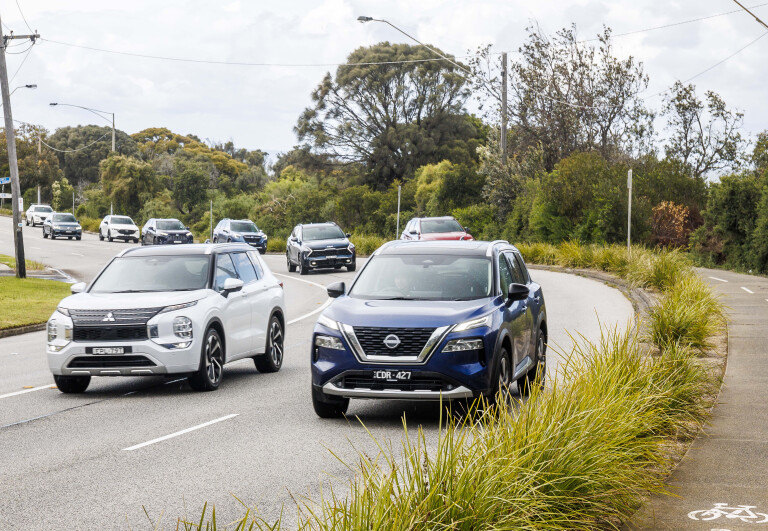
Specifications
| Model | Kia Sportage GT-Line diesel | Hyundai Tucson Highlander 1.6T N-Line | Mazda CX-5 G35 GT SP | Mitsubishi Outlander Exceed Tourer | Nissan X-Trail Ti | Subaru Forester 2.5i-S | Toyota RAV4 Cruiser Hybird 2WD | Volkswagen Tiguan 162TSI R-Line |
|---|---|---|---|---|---|---|---|---|
| Engine | 1999cc 4cyl, dohc, 16v, turbodiesel | 1598cc 4cyl, dohc, 16v, turbo | 1984cc, 4cyl, dohc, 16v | 2488 4cyl, doc, 16v | 2488cc 4cyl, doc, 16v | 2498cc 4cyl, dohc, 16v | 2487cc 4cyl, dohc, 16v combustion engine +88kW/202Nm AC electric motor | 1984cc, 4cyl, dohc, 16v |
| Max power | 137kW @ 4000rpm | 132kW @ 5000rpm | 170kW @ 5000rpm | 135kW @ 6000rpm | 135kW @ 6000rpm | 136kW @ 5800rpm | 160kW combined output | 162kW @ 6200rpm |
| Max torque | 416Nm @ 2000-2750rpm | 265Nm @ 1500-4500rpm | 420Nm @ 2000rpm | 244Nm @ 3600rpm | 244Nm @ 3600rpm | 239Nm @ 4400rpm | 221Nm @ 3600rpm (combustion engine only) | 350Nm @ 1500-4400rpm |
| Transmission | 8-speed automatic | 7-speed dual-clutch auto | 6-speed automatic | CVT automatic | CVT automatic | CVT automatic | CVT automatic | 7-speed dual-clutch auto |
| Weight | 1796kg | 1679kg | 1693kg | 1760kg | 1668kg | 1576kg | 1700kg | 1699kg |
| 0-100km/h | N/A | 8.8sec (est.) | 7.7 seconds (claimed) | 10.5sec (claimed) | 10.5sec (estimated) | N/A | N/A | 7.0 seconds (claimed) |
| Economy | 8.2L/100km (as-tested) | 10.2L/100km (as-tested) | 11.3L/100km (as-tested) | 9.7L/100km (as-tested) | 9.8L/100km (as-tested) | 10.0L/100km (as-tested) | 7.4L/100km (as-tested) | 10.5L/100km (as-tested) |
| Price | $52,720 (as-tested) | $51,900 (as-tested) | $52,485 (as tested) | $52,490 | $51,990 as tested | $46,340 | $48,200 | $61,790 (as-tested) |


COMMENTS